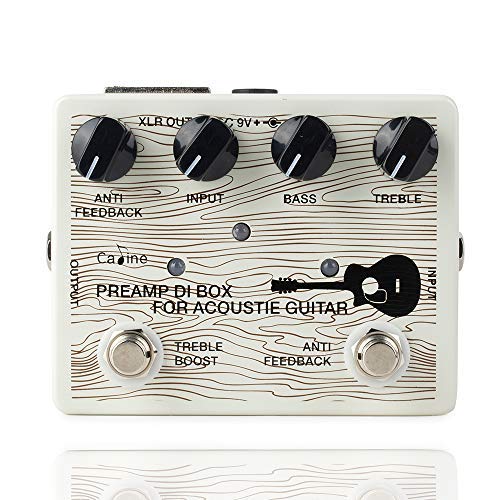Best Di Box For Electric Guitar (2024 Update)
When it comes to choosing the best DI box for your electric guitar, there are a few key factors you’ll want to consider before making a purchase. First and foremost, you’ll want to think about the inputs and outputs. Make sure the DI box has a high impedance input designed specifically for guitar pickups. You’ll also want outputs that are compatible with whatever amp, audio interface, or mixing console you plan to use.
Beyond that, think about sound quality and reliability. How transparent is the DI box? Does it accurately capture your guitar tone without coloration, noise, or artifacts? And is it sturdy enough for gigging and touring? You don’t want a flimsy unit that will fail on you mid-show.
Some other aspects to evaluate are whether the DI box offers any additional features like a ground lift switch, pad, or phantom power. And is it passive or active? Passive units are simpler and more transparent, while active units require batteries or power but offer more control. Ultimately, choosing the right DI comes down to matching your needs in terms of sound, build quality, and features.
Ready to find your perfect electric guitar DI box? Here are some key questions to ask yourself during the selection process: What guitar pickups do you use – single-coil, humbucker, or both? How do you want to shape your tone – transparently or with EQ coloration? Will you mainly use it live or in the studio? What connectivity options do you require? Considering these factors carefully will set you up for DI box success. Let the search begin!
10 Best Di Box For Electric Guitar
| # | Product Image | Product Name | Product Notes | Check Price |
|---|---|---|---|---|
|
1
|
The product is ideal for adding warmth, saturation, and character to recordings or live performances.
|
|
||
|
2
|
The product is ideal for connecting an electric guitar to a computer or recording device for high-quality sound recordings.
|
|
||
|
3
|
Ideal for guitar and bass players looking for a compact pedal that accurately simulates various amp cabinets.
|
|
||
|
4
|
This product is ideal for electric guitar and bass players looking to add harmonization, pitch shifting, and detuning effects.
|
|
||
|
5
|
It is an ideal tool for converting unbalanced signals from 1/4" jacks to balanced XLR inputs.
|
|
||
|
6
|
The product is ideal for enhancing the sound quality of an electric guitar using a compact effect pedal with true bypass.
|
|
||
|
7
|
The product is ideal for musicians who want to add a unique vocal effect to their guitar playing.
|
|
||
|
8
|
Ideal for guitar and bass players looking for a multi-effects pedal with amp modeling, IR cabinet simulation, MIDI I/O, and USB audio interface.
|
|
||
|
9
|
Ideal for creating guitar sound effects with voice-like quality by incorporating a talk box into amplifier setup.
|
|
||
|
10
|
The product is ideal for enhancing and modifying the sound of electric or acoustic guitars.
|
|
1. Jhs Colour Box V2 Preamp
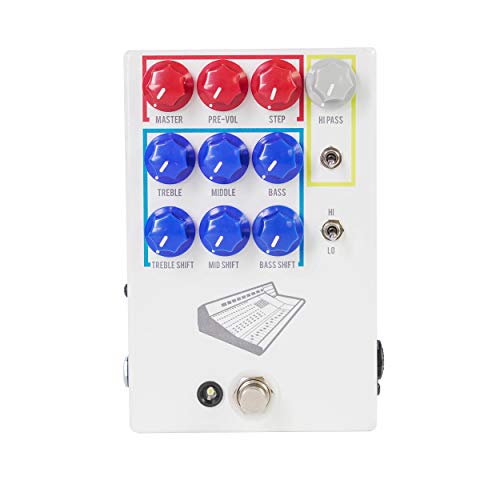
Introducing a top-of-the-line studio-grade preamplifier, EQ, and distortion generator, which boasts of compatibility with a wide range of instruments and microphones. This versatile unit features a Gain section that allows for precise control of the overall volume, the gain between the two internal gain stages, and the gain of each preamp stage in five different stages.
With the new Hi/Lo switch, users can achieve ultra-clean sounds without any distortion or opt for a broad range of overdrive, distortion, and fuzz sounds. The unit also includes a -20dB pad switch that tames the volume for high output microphones when in XLR input mode.
Further enhancing the EQ section is the newly added Shift knobs that adjust the range of frequencies that the Treble, Middle, and Bass knobs control, enabling users to achieve precise control over the EQ. The Hi-Pass section spans from 60Hz to 800Hz with a 6dB per octave slope.
This preamplifier is designed to deliver a 100% clean signal, even on acoustic guitars. It also features silent switching to eliminate any "switch-pop" sounds and can pass phantom power to condenser mics.
2. Quilter Labs Phantom Block Electric Guitar Interface
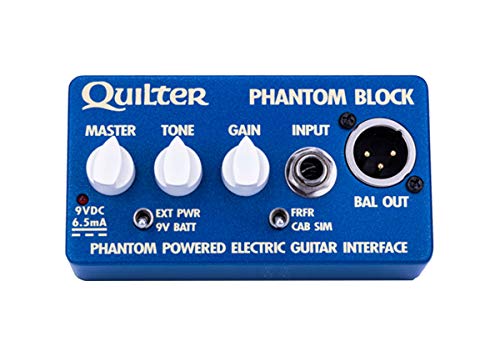
This direct box is the perfect solution for any musician looking to connect their electric guitar to a mixing board for live performances or recordings. It features a built-in gain control that ranges from clean to overdrive, giving you complete control over your tone. Additionally, the tone controls allow you to fine-tune your sound to your liking.
The direct box is powered by phantom power or a 9V power supply/battery (sold separately), giving you the flexibility to use it in a variety of settings. With its compact design, this direct box is easy to transport and can be used in any environment.
One of the standout features of this direct box is its ability to allow you to connect your electric guitar directly to a mixing board via XLR cable. This eliminates the need for a separate amplifier, making it an ideal choice for those looking for a simple and straightforward setup.
For acoustic-electric guitar and keyboards, the full range flat response mode is optimized to provide a clear and balanced sound. This mode ensures that your instrument's unique characteristics are accurately captured, resulting in a more natural and authentic sound.
3. Joyo Cab Box: Ir-Loaded Amp Simulator Pedal.
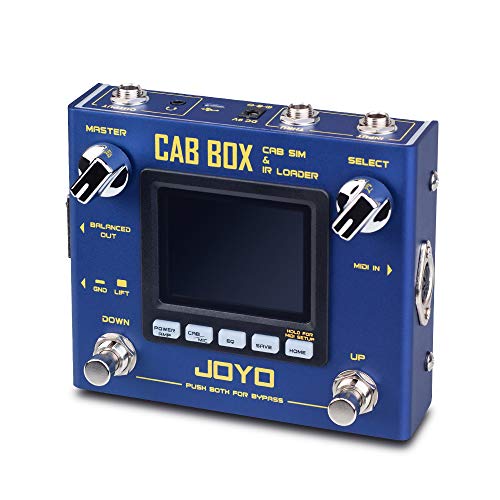
The JOYO CAB BOX is a cabinet modeling pedal that supports IR loading. With 4 tube power amp simulations, 20 cabinet models, and 11 classic microphone models, this pedal offers a range of options for guitarists to fine-tune their sound.
Compared to similar products on the market, the JOYO CAB BOX has a larger interface and screen with more buttons, making it easy to use. When it comes to IR, users can access 20 preset loading locations and store 10 third-party IRs.
The pedal can be connected to a PC through a USB, allowing users to edit tones and update firmware, load or delete third-party IRs, and it supports both Windows and Mac OS. With 128 tone store positions, users can easily switch between different tones in real time using MIDI controlled devices.
The JOYO CAB BOX can be connected to an amp's FX LOOP or other devices for stereo output. As a brand with over a decade of reputation, JOYO offers worry-free after-sale service. The brand has gained popularity among global guitarists for their budget pedals, amplifiers, wireless systems, controllers, metronomes, and tuners, inspiring people's music dreams.
Before playing, users should ensure that the guitar is fully connected to the pedal. To avoid unexpected noise and ensure proper functioning, it is recommended to purchase an extra JOYO original power adapter or choose another reliable brand that meets the working current requirement of a single pedal.
4. Harmonic Shift – Guitar Pedal For Perfect Pitch
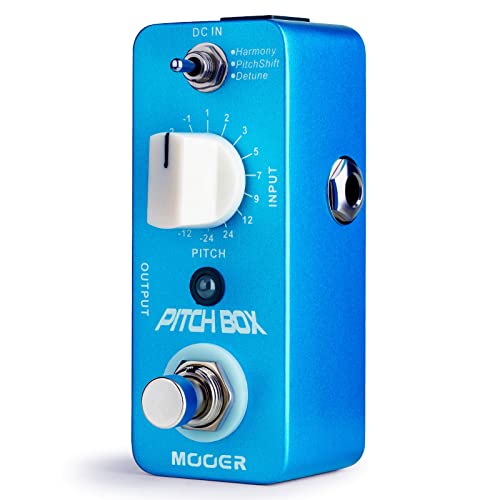
This cutting-edge product offers a range of pitch-shifting capabilities that are sure to impress any musician. With three distinct pitch modes to choose from – Harmony, Pitch Shift, and Detune – users can easily achieve a variety of effects and sounds to enhance their music.
One of the standout features of this product is its precise polyphonic pitch-shifting technology, which ensures that every note is accurately and seamlessly shifted to the desired pitch. With a pitch range of ±2 octaves, users have plenty of flexibility to experiment and create unique sounds.
The product is also designed with convenience in mind, featuring a true bypass function and a full metal shell that provides robust protection and durability. However, it is important to note that a DC 9V adapter power supply is required for operation, which is not included with purchase.
5. Hosa Dib443 Sidekick Passive Di Box 1/4" Ts To Xlr3m
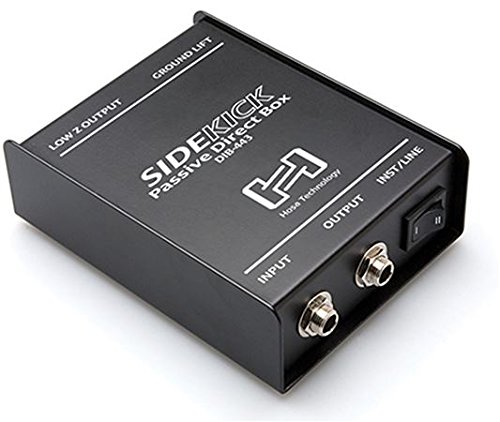
The Sidekick from Hosa Technology is a versatile passive DI box that allows for a clean, noise-free tone perfect for digital signal processing, or a natural, overdriven tone when using the INST/line switch in line position to drive your amplifier. This DI box is compatible with a wide range of electronic musical instruments, including electric guitars, basses, keyboards, and any instrument with a mono phone output.
With a high-quality isolation transformer that changes high impedance to low impedance output, the Sidekick is perfect for sending your signal over long distances using a balanced microphone cable or stage snake. The DI box also imparts a slight gain to your signal and features a Hi-Z output for sending to your on-stage amplifier.
Whether you're using pedal effects or effects processors, the Sidekick ensures a pure, clean sound that is free of noise and interference. Its passive design means that it doesn't require any external power, making it easy to use and transport.
6. Amuzik Di Box Effect Pedal Matchbox Effector For Electric Guitar Pedal With Ture Bypass Mini Size
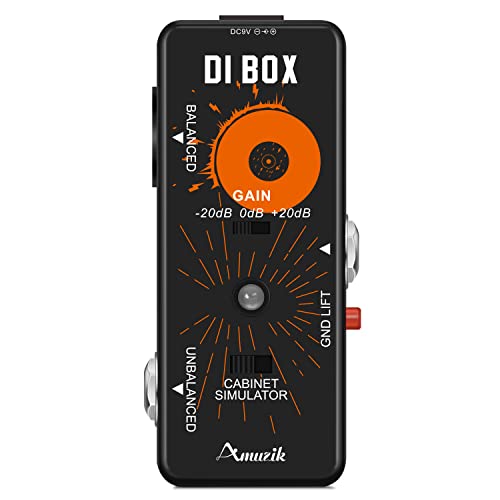
The DI BOX smart direct input box is an essential gadget for guitar and bass players. It boasts ultra-low distortion, which allows for the quiet transfer of sound directly from the instrument to the audio system. With a balanced/unbalanced output, gain switch, cabinet simulator, and ground lift function, this DI box provides all the necessary features for a top-notch performance.
True bypass is another significant advantage of this DI box. It ensures that the tone remains transparent, thus minimizing tone loss and preserving the best quality sound. The DI BOX features a pure analog design, with carefully selected components that guarantee the best sound quality and road performance.
In addition to its high-quality features, the DI BOX is also affordable. Its compact size, which is nano-sized, allows for more pedals to fit on a pedal board and reduces the overall weight. The solid case is made of high-quality zinc alloy, making it durable and sturdy.
The DI BOX smart direct input box comes with a 100% satisfaction guarantee. The manufacturer's top priority is customer satisfaction, and they offer a 12-month warranty and a 30-day unconditional money-back guarantee. If you have any questions about the product, their customer service team is always ready to help.
7. Dunlop Mxr M222 Talk Box W/4 Cables
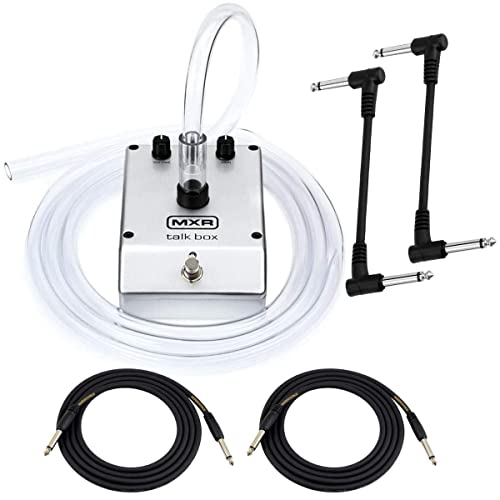
The Classic Talk Box is a remarkable self-contained unit that can produce top-notch talk box sounds. It comes with a host of features that enable users to shape and add texture to their Talk Box voice, making it sound even more impressive.
One of the standout features of this unit is the tone and gain controls. These controls allow users to adjust the tone and gain of the sound produced by the Talk Box, giving them more control over the output. With these controls, users can fine-tune their Talk Box voice to match their desired sound quality.
Another impressive feature of the Classic Talk Box is its built-in amplifier. This amplifier delivers clean and robust sound, ensuring that the output is of the highest quality.
Furthermore, the Classic Talk Box comes with surgical tubing and a mic clip, making it easy to set up and use. The surgical tubing is flexible and durable, while the mic clip ensures that the microphone stays in place during use.
8. Ultimate Multi-Effect Pedal With Expression Control
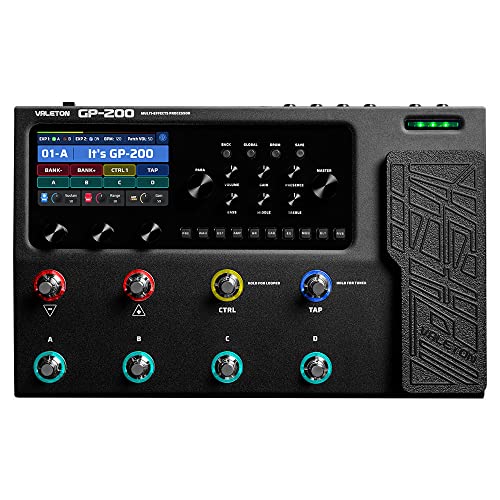
The Multi Effects Processor is a versatile and powerful pedal that is perfect for guitar, bass, and acoustic players. With over 240 built-in effects, 140 amplifier and cabinet simulations, and 100 stompbox effect pedals, this pedal has everything you need to create your perfect sound.
Equipped with the new-gen HD modeling technology, this pedal has a 24-bit 44.1kHz signal processing that ensures high-quality sounds. The Multi Effects Processor also features 100 built-in drum rhythms and a 180-second looper, making it an ideal choice for live performances and recording sessions.
The pedal has 256 presets and an adjustable signal chain that supports up to 11 simultaneous effect blocks. It also has a 4.3-inch TFT color LCD screen with a user-friendly interface and eight customizable LED footswitches, making it easy to navigate and control.
The Multi Effects Processor has various connection options, including Line, XLR, and headphone I/O, an FX loop for inserting external stompboxes, MIDI IN and EXP2 jack for connecting external controllers. It also has a USB Type-C connection audio interface with stereo audio streaming, and it supports OTG function for directly connecting to iOS/Android mobile devices.
The Multi Effects Processor has a multi-language user interface (hardware) and comes with free Mac/Windows software for sound editing and preset managing, making it easy to customize and save your settings.
9. Dunlop Mxr M222 Talk Box W/ Patch Cable, Tuner, And Strap
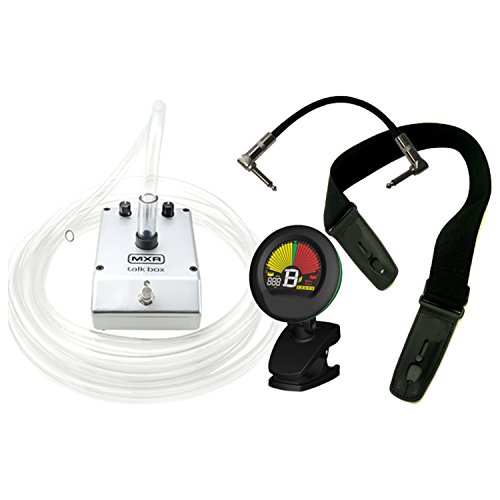
The MXR team has carefully crafted a must-have addition for modern gigging musicians with their latest offering. This compact and pedalboard-friendly device comes complete with a 6" patch cable, tuner and locking strap, making it convenient for musicians to carry around without the need for a separate rig.
The device has been meticulously fine-tuned by the MXR team to deliver exceptional tone sculpting capabilities for modern gigs. With its own amp and speaker driver, you can expect top-notch sound quality that is sure to impress any audience.
The volume, tone and gain controls allow musicians to shape their sound and add texture to their performances with ease. This device is perfect for musicians who want to create a unique and customized sound for their performances.
In addition to its impressive features, this device is also incredibly user-friendly, making it suitable for musicians of all skill levels. The compact design and pedalboard-friendly size make it easy to carry around, while the intuitive controls allow for effortless customization of your sound.
Best Di Box For Electric Guitar FAQs
Are there any budget-friendly DI boxes that still provide high-quality sound for electric guitars?
Yes, there are several budget-friendly DI boxes available in the market that provide high-quality sound for electric guitars. DI boxes are used to convert the unbalanced signal from the guitar into a balanced signal that can be sent to a mixer or recording device. The following are some budget-friendly DI boxes that offer high-quality sound:
1. Behringer Ultra-DI DI400P: It is a passive DI box that offers a high-impedance input for guitars and a balanced XLR output. It is affordable and provides a clean and clear sound.
2. Radial Engineering ProDI: It is a passive DI box that provides a flat frequency response and excellent signal handling. It is also compact and easy to use.
3. ART DualZDirect: It is an active DI box that offers two channels and a switchable ground lift. It provides a warm and natural sound and is ideal for recording and live performances.
In conclusion, there are several budget-friendly DI boxes available in the market that provide high-quality sound for electric guitars. It is important to choose a DI box that suits your needs and budget.
Can a DI box be used for both live performances and recording electric guitars?
Yes, a DI (Direct Injection) box can be used for both live performances and recording electric guitars. In live performances, a DI box is commonly used to convert the high-impedance signal from an electric guitar into a low-impedance signal that can be sent through a long cable without losing any signal quality. This helps to reduce noise and interference in the signal path, resulting in a clearer and more reliable sound.
In recording scenarios, a DI box can be used to capture the sound of an electric guitar directly into a recording interface or mixer. This is especially useful when recording in a home studio or in a situation where miking up an amp is not possible or desirable. A DI box can also help to capture a consistent tone from the guitar, as the direct signal is not affected by the acoustics of the room or the placement of microphones.
Overall, a DI box is a versatile tool that can be used for both live performances and recording sessions, making it a valuable addition to any guitarist's setup.
Can a low-quality DI box negatively affect the sound of an electric guitar?
Yes, a low-quality DI (Direct Input) box can negatively affect the sound of an electric guitar. The DI box is responsible for converting the high-impedance signal of an electric guitar into a low-impedance signal that can be sent to a mixing console or audio interface. A low-quality DI box may not be able to handle the high-frequency and dynamic range of an electric guitar, resulting in a loss of clarity and tone. This can lead to a thin, dull, or distorted sound that lacks the richness and depth of a high-quality DI box. In addition, a low-quality DI box may introduce noise, hum, or interference into the signal, further degrading the sound quality. Therefore, it is important to invest in a high-quality DI box that can properly handle the unique characteristics of an electric guitar and deliver a clean, accurate, and full-bodied sound.
Do different types of electric guitars require different types of DI boxes?
Yes, different types of electric guitars may require different types of DI boxes. This is because the output signal of an electric guitar can vary depending on the type of pickups, wiring, and electronics used. For example, a guitar with single-coil pickups may produce a brighter and thinner sound compared to a guitar with humbucker pickups, which can produce a warmer and fuller sound.
Therefore, it is important to choose a DI box that is compatible with the specific type of electric guitar being used. Some DI boxes may have adjustable impedance settings to accommodate different types of pickups, while others may have tone shaping options to enhance or adjust the sound of the guitar.
It is also worth noting that some electric guitars may not require a DI box at all, especially if they have built-in preamp circuits or are plugged directly into an amplifier or audio interface. Ultimately, the choice of DI box will depend on the specific needs and preferences of the musician or audio engineer.
How do DI boxes improve the sound of electric guitars?
DI boxes, also known as direct injection boxes, improve the sound of electric guitars by converting the high-impedance, unbalanced signal from the guitar into a low-impedance, balanced signal that can be sent through a mixer or audio interface. This helps to prevent signal loss and noise interference that can occur when sending the guitar signal directly to a mixing board or amplifier.
DI boxes also provide impedance matching, which ensures that the guitar signal is properly matched to the input of the mixer or audio interface. This results in a more accurate and consistent tone, with improved clarity and detail. Additionally, many DI boxes feature ground lift switches, which can help to eliminate hum and buzz caused by ground loops in the audio system.
Overall, using a DI box with an electric guitar can greatly improve the sound quality and reliability of the signal, making it an essential tool for recording and live performance.
How do I properly set up and use a DI box for my electric guitar?
To properly set up and use a DI box for your electric guitar, follow these steps:
1. Choose the right DI box: There are different types of DI boxes. For guitar, you need a passive DI box that can handle high impedance signals. Look for a DI box with a "thru" output to send the signal to your amp.
2. Connect your guitar: Plug your guitar into the input jack of the DI box using a standard guitar cable.
3. Connect to the PA system: Connect the XLR output of the DI box to the input of the PA system or recording device using an XLR cable. Make sure to adjust the gain levels to avoid distortion.
4. Adjust the ground lift: If you experience any unwanted noise or hum, try adjusting the ground lift switch on the DI box.
5. Adjust EQ settings: Use the EQ settings on the PA system or recording device to adjust the tone of your guitar.
6. Test and adjust: Play your guitar and adjust the levels as needed to get the desired sound.
By following these steps, you can properly set up and use a DI box for your electric guitar.
Is it necessary to use a DI box when recording electric guitars?
Using a DI (Direct Injection) box when recording electric guitars depends on the type of sound you want to achieve and the equipment you are using. A DI box is typically used to convert the high impedance signal of an electric guitar into a low impedance signal that can be captured by recording equipment such as an audio interface or mixing console.
If you are recording an electric guitar with a preamp or amplifier, you may not need to use a DI box as the signal has already been converted to a low impedance level. However, if you want a clean, direct sound without any added coloration from an amp or preamp, a DI box can be useful.
Additionally, a DI box can help eliminate ground loop hum or interference caused by other nearby electrical equipment. It can also provide a consistent sound if you are recording multiple guitars with different setups.
In summary, using a DI box when recording electric guitars is not always necessary, but it can be helpful in achieving a clean, direct sound and eliminating unwanted interference.
What are the top-rated DI boxes for electric guitar?
There are several DI boxes available in the market for electric guitar, but the top-rated ones are the Radial JDI, Countryman Type 85, and the Tech 21 SansAmp Bass Driver DI. The Radial JDI is a high-quality passive DI box that provides exceptional sound clarity and reliability. It is perfect for recording or live performances. The Countryman Type 85 is a versatile active DI box that can handle high-output instruments like electric guitars and basses. It is known for its transparent tone and low noise level. The Tech 21 SansAmp Bass Driver DI is a popular DI box among guitarists and bassists. It features a range of amp modeling options, allowing you to achieve a variety of tones without the need for additional gear. Overall, these DI boxes are highly recommended by professionals in the music industry and are sure to enhance the sound quality of your electric guitar.
What features should I look for in a DI box for electric guitar?
When it comes to selecting a DI box for an electric guitar, there are several important features to consider. Firstly, the input impedance is key. You will want a DI box with a high input impedance (ideally around 1 megohm) to maintain the integrity of the guitar's signal. Next, consider the output options. Look for a DI box that offers both balanced XLR and unbalanced 1/4" outputs to ensure compatibility with a range of equipment. Ground lift switches are also useful to eliminate any unwanted hum or buzz in the signal. Additionally, some DI boxes offer features such as pad switches to prevent overloading the input and EQ controls to shape the tone of the guitar's signal. Finally, portability and durability are important factors to consider if you plan on using the DI box for live performances. Look for a compact and rugged design that can withstand the rigors of touring.
What is the difference between an active and passive DI box for electric guitar?
An active DI box for electric guitar is a device that requires external power to operate and typically includes a preamp stage to boost the signal level. The preamp allows the active DI box to provide additional gain and impedance matching, which can be useful in situations where the guitar signal is weak or needs to be amplified. Active DI boxes also typically have more control over the tone and sound of the guitar signal, allowing for adjustments to the EQ and other parameters.
On the other hand, a passive DI box for electric guitar does not require external power and typically does not include a preamp stage. Instead, it uses a transformer to match the impedance of the guitar signal to the input of the recording or sound system. Passive DI boxes are typically simpler in design and offer less control over the tone and sound of the guitar signal, but can be useful in situations where a more natural and unaltered sound is desired.
Overall, the choice between an active and passive DI box for electric guitar will depend on the specific needs and preferences of the guitarist or recording engineer.


